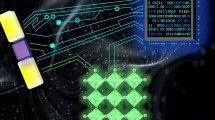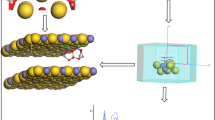Abstract
A systematic density functional investigation on the structural, electronic and optical properties of the growth of (ZnO)6 cluster unit in the series of (ZnO)6n for n = 1–9 is reported in this paper. Different electronic properties of (ZnO)6n nanoclusters are analyzed in terms of HOMO–LUMO gap (HLG), ionization potential (IP), electron affinity (EA), chemical hardness (η) and electrophilicity index (ω), which all shows a zigzag behavior as the size of (ZnO)6n clusters increases. The electronic energy gain (ΔE) of the clusters identified an exceptionally stable ‘magic’ nanocluster, viz. (ZnO)42. Frontier orbitals analysis results indicate easy electron transfer in (ZnO)42 nanocluster system. The optical absorption spectra confirm that the magic (ZnO)42 nanocluster is active in the visible range (λ = 406.8 Å) of electromagnetic spectrum. Interestingly, like zigzag electronic properties, similar optical switching toward the growth of (ZnO)6 unit is also observed. The simulation results of electronic properties as well as the infrared spectra of magic (ZnO)42 cluster will open up a vista to the experimentalists for its possible synthesis, which in turn will help in the development of the visibly active magic (ZnO)42 nanocluster with novel applications in the fields of quantum dots or assembled materials.







Similar content being viewed by others
References
Jena P, Khanna SN, Rao BK (1999) (1999) Theory of atomic and molecular clusters 27–53. Springer
Kappes MM, Kunz RW, Schumacher E (1982) Production of large sodium clusters (Nax, x < 65) by seeded beam expansions. Chem Phys Lett 91:413–418
Ekardt W (1984) Dynamical polarizability of small metal particles - self-consistent spherical jellium background model. Phys Rev Lett 52:1925–1928
Bergeron DE, Castleman AW, Morisato T, Khanna SN (2004) Formation of Al13I–: evidence for the superhalogen character of Al13–. Science 304:84–87
Knight WD et al (1984) Electronic shell structure and abundances of sodium clusters. Phys Rev Lett 52:2141–2143
Roy DR, Singh PK (2013) Magic stability of Ga4Mg3 cluster in GaxMg3 (x=1-6) series: a density functional study. Chem Phys 411:6–10
Khatua S, Roy DR, Chattaraj PK, Bhattacharjee M (2007) Synthesis and structure of 1D Na6 cluster chain with unusual short na-na distance: organic like aromaticity in inorganic metal cluster. Chem. Commun. 135–137
Kappes MM, Radi P, Schar M, Schumacher E (1985) Probes for electronic and geometrical shell structure effects in alkali-metal clusters. Photoionization measurements on KxLi, KxMg and KxZn (x<25). Chem Phys Lett 119:11–16
Khatua S, Roy DR, Bultinck P, Bhattacharjee M, Chattaraj PK (2008) Aromaticity in cyclic alkali clusters. Phys Chem Chem Phys 10:2461–2474
Roy DR, Shah EV, Mondal Roy S (2018) Optical activity of co-poprhyrin in the light of IR and raman spectroscopy: a critical DFT investigation. Spectroch. Acta A 190:121–128
Watanabe HI, Inoshita T (1986) Superatom: a novel concept in materials science. Optoelectron Dev 1:33–39
Tung NT, Janssens E, Lievens P (2014) Dopant dependent stability of Co n TM+ (TM = Ti, V, Cr, and Mn) clusters. Appl Phys B 114(4):497–502
Asaduzzaman AM, Blackman JA (2010) Magnetism in binary and encapsulated Co-Mn clusters. Phys Rev B 82:134417
Honkala K (2014) Tailoring oxide properties: an impact on adsorption characteristics of molecules and metals. Surf Sci Rep 69(4):366
Henrich VE, Cox PA (1996) The Surface Science of Metal Oxides, vol 1. Cambridge University Press, Cambridge, UK
Danish MSS, Bhattacharya A, Stepanova D, Mikhaylov A, Grilli ML, Khosravy M, Senjyu T (2020) A systematic review of metal oxide applications for energy and environmental sustainability. Metals 10:2075–4701
Biswas S, Sharma P, Awasthi V, Sengar BS, Das AK, Mukherjee S (2016) Photosensitive ZnO-graphene quantum dot hybrid nanocomposite for optoelectronic applications. ChemistrySelect 1:1503–1509
Mohiuddin M, Kumar B, Haque H (2017) Biopolymer composites in photovoltaics and photodetectors. In: Sadasivuni KK, Ponnamma D, Kim J, Cabibihan J-J, AlMaadeed MA (eds) Biopolymer composites in electronics. Elsevier, pp 459–486
Tiginyanu IM, Lupan O, Ursaki VV, Chow L, Enachi M (2011) Nanostructures of Metal Oxides. In: Bhattacharya P, Fornari R, Kamimura H (eds) Comprehensive semiconductor science and Technology. Elsevier, pp 396–479
Stehr JE, Chen WM, Reddy NK, Tu CW, Buyanova IA (2015) Efficient nitrogen incorporation in ZnO nanowires. Sci Rep 5:13406
Soci C, Zhang A, Xiang B, Dayeh SA, Aplin DPR, Park J, Bao XY, Lo YH, Wang D (2007) ZnO nanowire UV photodetectors with high internal gain. Nano Lett 7:1003–1009
Rackauskas S, Barbero N, Barolo C, Viscardi G (2017) ZnO nanowires for dye sensitized solar cells. In nanowires-new insights. IntechOpen. https://doi.org/10.5772/67616
Znajdek K, Sibi’nski M, Lisik Z, Apostoluk A, Zhu Y, Masenelli B, Sedzicki P (2017) Zinc oxide nanoparticles for improvement of thin film photovoltaic structures’ efficiency through down shifting conversion. Opto-Electron. Rev. 25:99–102
Zhang XM, Lu MY, Zhang Y, Chen LJ, Wang ZL (2009) Fabrication of a high- brightness blue-light-emitting diode using a ZnO-nanowire array grown on p-GaN thin film. Adv Mater 21:2767–2770
Zhang Y, Nayak TR, Hong H, Cai W (2013) Biomedical applications of Zinc oxide nanomaterials. Curr Mol Med 13:1633–1645
Jena P, Sun O (2020) Super atomic clusters: design rules and potential for building blocks of materials. Chem Rev 120:9021–9163
Li H, Li L, Pedersen A, Gao Y, Khetrapal N, Jónsson J, Zeng XC (2015) Magic- number gold nanoclusters with diameters from 1 to 3.5 nm: relative stability and catalytic activity for CO oxidation. Nano Lett. 15:682–688
McKee ML, Samokhvalov A (2017) Density functional study of neutral and charged silver clusters Agn with n=2–22 evolution of properties and structure. J. Phys Chem A 121:5018–5028
Kukreja LM, Rohlfing A, Misra P, Hillenkamp F, Dreisewerd K (2004) Cluster formation in UV laser ablation plumes of ZnSe and ZnO studied by time-of-flight mass spectrometry. Appl Phys A 78:641–644
Dmytruk A, Dmitruk I, Blonskyy I, Belosludov R, Kawazoe Y, Kasuya A (2009) ZnO clusters: laser ablation production and time-of-flight mass spectroscopic study. Microelectron J 40:218–220
Chen M, Straatsma TP, Fang Z, Dixon DA (2016) Structural and electronic property study of (ZnO)n, n ≤ 168: transition from zinc oxide molecular clusters to ultrasmall nanoparticles. J Phys Chem C 120:20400–20418
Gaikwad PV, Pujari PK, Chakroborty S, Kshirsagar A (2017) Cluster assembly route to a novel octagonal two-dimensional ZnO monolayer. J Phys Cond Matter 29:335501
Hohenberg P, Kohn W (1964) Inhomogeneous electron gas. Phys Rev B 136:B864–B871
Kohn W, Sham LJ (1965) Self-consistent equations including exchange and correlation effects. Phys Rev A 140:A1133–A1138
Parr RG, Yang W (1989) Density functional theory of atoms and molecules. Oxford University Press, New York
Becke AD (1993) Density-functional thermochemistry. III. The role of exact exchange. J Chem Phys 98:5648–5652
Dunning Jr TH, Hay PJ (1976) in ‘Modern Theoretical Chemistry’, H.F. Schaefer III (Ed.), Vol. 3, Plenum, New York
Hay PJ, Wadt WR (1985) Ab initio effective core potentials for molecular calculations. potentials for the transition metal atoms Sc to Hg. J Chem Phys 82:270–283
Hay PJ, Wadt WR (1985) Ab initio effective core potentials for molecular calculations - potentials for the transition-metal atoms Sc to Hg. J Chem Phys 82:270–283
Frisch MJ et al (2009) Gaussian 09, Revision E.01. Gaussian Inc., Wallingford CT
Roy DR. Chattaraj PK (2021)‘Conceptual DFT and aromaticity' in aromaticity (1st Ed.), Israel Fernández (Ed.), Elsevier: MA.
Pearson RG (1973) Hard and soft acids and bases. Dowden, Hutchinson and Ross, Stroutsberg, PA
Parr RG, Pearson RG (1983) Absolute hardness: companion parameter to absolute electronegativity. J Am Chem Soc 105:7512–7516
Parr RG, Szentpaly LV, Liu S (1999) Electrophilicity index. J Am Chem Soc 121:1922–1924
Chattaraj PK, Roy DR (2007) Update 1 of: electrophilicity index. Chem. Rev. 107:PR46–PR74
Chattaraj PK, Sarkar U, Roy DR, Elango M, Parthasarathi R, Subramanian V (2006) Is electrophilicity a kinetic or A thermodynamic concept? Ind J Chem A 45A:1099–1112
Marques MAL, Gross EKU (2004) Time-dependent density functional theory. Ann Rev Phys Chem 55:427–455
Casida ME, Huix-Rotllant M (2012) Progress in time-dependent density-functional theory. Annu Rev Phys Chem 63:287–323
Fogarasi G, Pulay P (1985) In Vibrational Spectra and Structure. Durig JR (Ed.), Elsevier: New York, Vol 13.
Califano S (1976) Vibrational states. Wiley, New York
Swinehart DF (1962) The beer-lambert law. J Chem Educ 39:333
Swinehart, D.F. Analytical chemistry: an introduction (Saunders Golden Sunburst Series) Skoog. In: D.A., West, D.M. & Holler, F.J. (Ed) (1999).
Mulliken RS (1955) Electronic population analysis on LCAO-MO molecular wave functions. I J Chem Phys 23:1833–1840
Acknowledgements
DRR is thankful to the SERB, New Delhi, Govt. of India for financial support (Grant Nos. EMR/2016/005830 and CRG/2020/002634). SMR is thankful to the SERB, New Delhi, Govt. of India for financial support (Grant No. TAR/2021/000150).
Author information
Authors and Affiliations
Contributions
BRM contributed to investigation, results, and writing—original draft. EVS contributed to investigation, results, and writing—original draft. SMR contributed to conceptualization, supervision, results analysis, writing—review and editing. DRR contributed to conceptualization, supervision, results analysis, writingβ—review and editing, resources.
Corresponding authors
Ethics declarations
Conflicts of interest
The authors declare no competing financial interest.
Additional information
Publisher's Note
Springer Nature remains neutral with regard to jurisdictional claims in published maps and institutional affiliations.
The authors dedicate this work to Professor Pratim Kumar Chattaraj on his 65th birth anniversary.
Supplementary Information
Below is the link to the electronic supplementary material.
Rights and permissions
Springer Nature or its licensor (e.g. a society or other partner) holds exclusive rights to this article under a publishing agreement with the author(s) or other rightsholder(s); author self-archiving of the accepted manuscript version of this article is solely governed by the terms of such publishing agreement and applicable law.
About this article
Cite this article
Mehta, B.R., Shah, E.V., Mondal Roy, S. et al. (ZnO)42 nanocluster: a novel visibly active magic quantum dot under first principle investigation. Theor Chem Acc 142, 19 (2023). https://doi.org/10.1007/s00214-023-02958-1
Received:
Accepted:
Published:
DOI: https://doi.org/10.1007/s00214-023-02958-1




